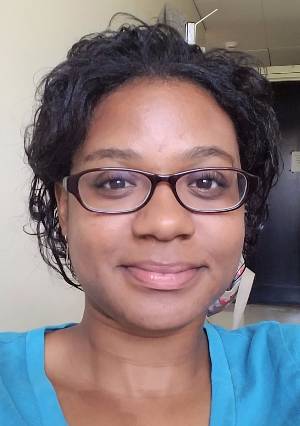CIE Researcher of Distinction, October 2016
Melissa Sims
Each month, the Center for Inclusive Education showcases the outstanding research being conducted by one of our talented scholars in our Research Café series. In addition, we recognize this scholar as a Researcher of Distinction and share the details of his/her journey to becoming an accomplished scholar. This month's Researcher of Distinction is Melissa Sims, PhD candidate in the Department of Geosciences. Melissa presented her talk, ‘Simulating Meteorite Impact in the Diamond Anvil Cell’ on Tuesday, October 11, 2016.
Melissa's Path Into Research
I’m a third year geoscience PhD candidate, originally from South Carolina. I attended the College of Charleston, where I earned a BA in physics, and the University of South Carolina, where I earned a BS in geophysics. At USC, I processed seismic data for the Earth Sciences and Resources Institute’s $10 million DOE Carbon Sequestration Project for geologic characterization of the South Georgia Rift basin for source proximal CO2 storage. I completed a MS in geosciences through the “Career Path for African-American Students from HBCUs to National Laboratories” program here at Stony Brook. I decided to stay at Stony Brook for the PhD program. In my first year, I was chosen to Introduce of Department of Energy Secretary Ernest Moniz at the Brookhaven National Lab Commencement Ceremony. I work in mineral physics and planetary science in Dr. Lars Ehm's group. I’m a Turner, Bridge to the Doctorate and AGEP-T Fellow.
Melissa's Current Research
Describe the work you presented for your Research Café.
We study the phase diagram of the plagioclase ((Na1-x Cax)Al1+x Si2-x O8) system as a function of strain-rate, overpressure, and temperature. The objective is to determine the effect of the pressure-temperature (loading) path on plagioclase phase formation and preservation during impact events. Plagioclase is a mineral that is ubiquitous on rocky bodies throughout the solar system; particularly on the Earth, numerous meteorites, and in lunar mare and highlands. It can be altered through shock metamorphism. Shock results from impacts between planetary bodies and plays an important role in secondary processing in the solar system. As pressures and temperatures increase, plagioclase proceeds through stages of deformation (brittle fracture, plastic deformation), formation of maskelynite and a high pressure polymorph, and finally terminates in melting. Impactites are characterized based on methods that use static and shock experiments to gage pressure and temperature conditions based on phase formation during impacts. These experiments have differences in timescale, temperature, path, and strain-rate compared to each other or natural events. For some phases, the experiments can have large discrepancies in formation pressure. We utilize a new diamond anvil cell (DAC) technique, rapid compression, combined with laser heating and in situ synchrotron X-ray diffraction in order to study previously inaccessible loading paths. Rapid compression allows DAC experiments to change pressure while observing. The method allows independent constraint of pressure and temperature, which is not possible in shock experiments. It is the closest study to timescales suggested by the meteorites found to date. Calibration of the plagioclase phase diagram in terms of strain rate and timescale could produce a more accurate compositional analysis of various meteorites/craters and a better picture of the impact events that created them. The series of experiments primarily represent a necessary building block towards experiments on realistic timescales for melt veins and impact centers; essentially simulating meteorite impacts in the diamond anvil cell.
Are there any other projects, beyond your Research Café work, that you are currently working on?
My future will build on my Research Café work while incorporating higher rates and temperatures as well as different materials. We would like to build toward simultaneous temperature and pressure variation on the timescales suggested by melt veins in numerous meteorites that have been discovered.
What was the deciding factor for you to come to Stony Brook for your graduate studies?
I decided to come to Stony Brook after I heard about their paid master’s program for a “Career Path for African-American Students from HBCUs to National Laboratories” from my advisor at USC. I wanted to find out why a bunch of geologists would need a particle accelerator.
What are your future goals?
I would like to do a postdoc and stay in academics, although the national labs have also been very interesting.
What do you enjoy most about research?
Picking just one thing is a little hard. I like solving puzzles. I also like the freedom; the ability to develop your project in original ways. I really like my project because I’m working in a field with extensive history where we now have the ability to make contributions that were previously only speculated about.
